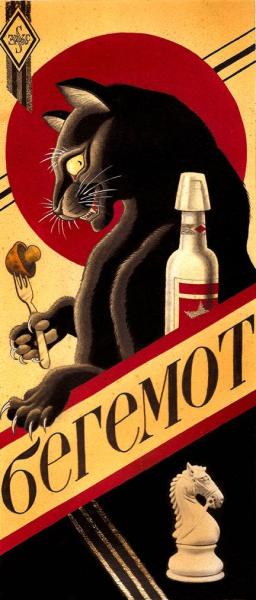A Hippo By Any Other Name Would Be My Cat
On April 8th, Inna and I adopted our first joint-custody cat, an 18 month old longhair tuxedo whom the shelter had christened “Trent”.
The biggest problem we’ve had with him has been choosing a suitable new moniker, since “Trent” did nothing for any of us.
I brainstormed a list of 55 names I’ve suggested, and I’m sure Inna’s list was equally long; the problem being that we each hated the other’s.
The ones we came closest to agreeing on included:

And then there were some awesome ones that I offered which were summarily rejected, like:
Ultimately Inna came up with something that we could both appreciate, being unique, humorous, and utterly surreal. The little guy will forevermore be known as:
Бегемот
Yes, that’s Cyrillic, because it’s a Russian name (in case you don’t know, Inna’s a first-generation transplant from Ukraine). For those readers who don’t read/speak Russian, you can approximate the pronunciation via the English mnemonic: “Big-Emote” (which apparently horrifies my live-in native speaker). Or, if you have the technology, you can play Google Translate’s pronunciation here.
Okay, I get it: Big-Emote. What’s it mean?
Here’s where things get interesting, because Begemot has *lots* of meanings.
Let’s start with the most basic. Begemot. The Russian word comes from a Hebrew word “behemah”, from which also derives the English word “behemoth”. Hence “behemoth”: a huge or monstrous creature. Good name for a cat, even if our little guy isn’t even ten pounds yet. Although given the size of his ridiculous outrigger paw-pontoons, he might just grow into the name…
As a proper noun, Behemoth is also a specific Biblical monster, the land-borne equivalent of the ocean-borne Leviathan. The Book of Job identifies him as “the first of the works of God”, a grass-eater who shelters in the reeds and marsh. Interpreters seeking a real-world manifestation of the passage have most often associated Behemoth with the hippopotamus, and sometimes as an elephant, rhinoceros, or buffalo. So Begemot is an official Old Testament Hebrew name, too!
Which brings us back to Russian, because in the mid-1700s, Russian language speakers dropped the word “gippopotam” in favor of “begemot” for the hippo. Hence a second interpretation that points toward the hippopotamus! Maybe not the best name for a cat, but certainly unique!

And finally we come around to the literary referent. Begemot is the name of a character in a very prominent and well-known Russian novel: “The Master and Margarita” by Mikhail Bulgakov. While I haven’t read it, it sounds like something of a dreamlike surrealist description of Christianity and atheism in pre-WW2 Soviet USSR.
In the novel, Begemot isn’t just your average character. His Wikipedia entry describes him thus: He is an enormous (said to be as large as a hog) demonic black cat who speaks, walks on two legs, and can even transform to human shape for brief periods. He has a penchant for chess, vodka, pistols, and obnoxious sarcasm. He is evidently the least-respected member of Woland’s [Satan’s] entourage; Margarita [the heroine] boldly takes to slapping Behemoth on the head after one of his many ill-timed jokes, without the fear of retribution. His Russian name Begemot means hippopotamus, but also refers to the legendary Biblical monster. He is known for his jokes which he never stops telling.
So there we have it. Begemot: a huge creature, an Old Testament monstrosity, who is twice-over associated with hippopotamuses, and simultaneously an enormous anthropomorphic talking black cat who is Satan’s pageboy.
With all that going for it, it was hard to resist adopting that name. So now we have our own little Begemot running around the house. Let’s hope he doesn’t start showing any of his namesake’s attributes!